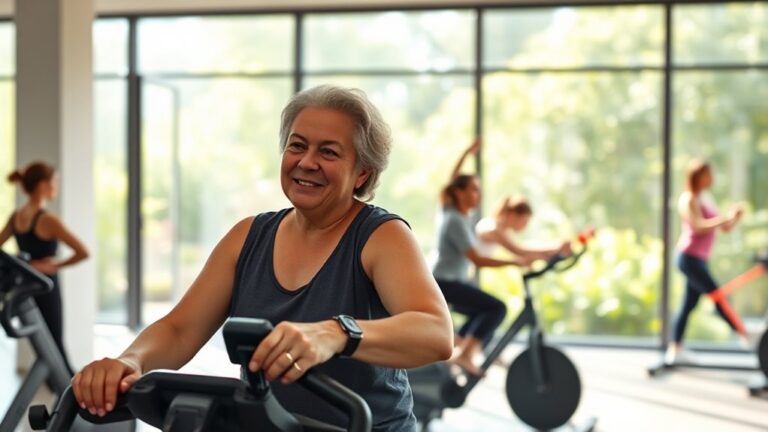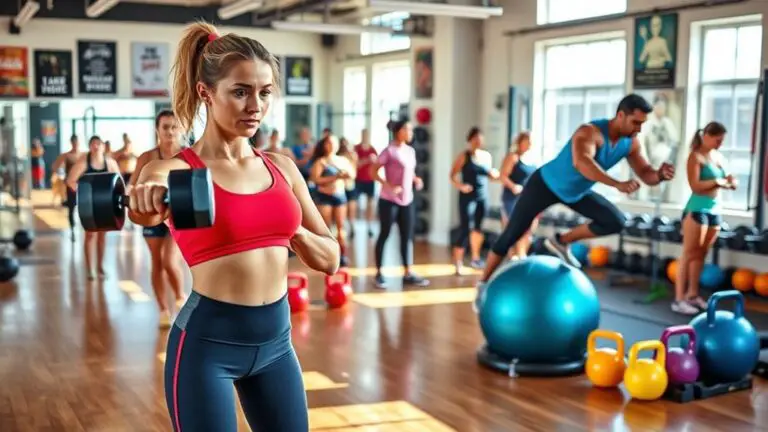The Best Yoga Poses for Strength Athletes
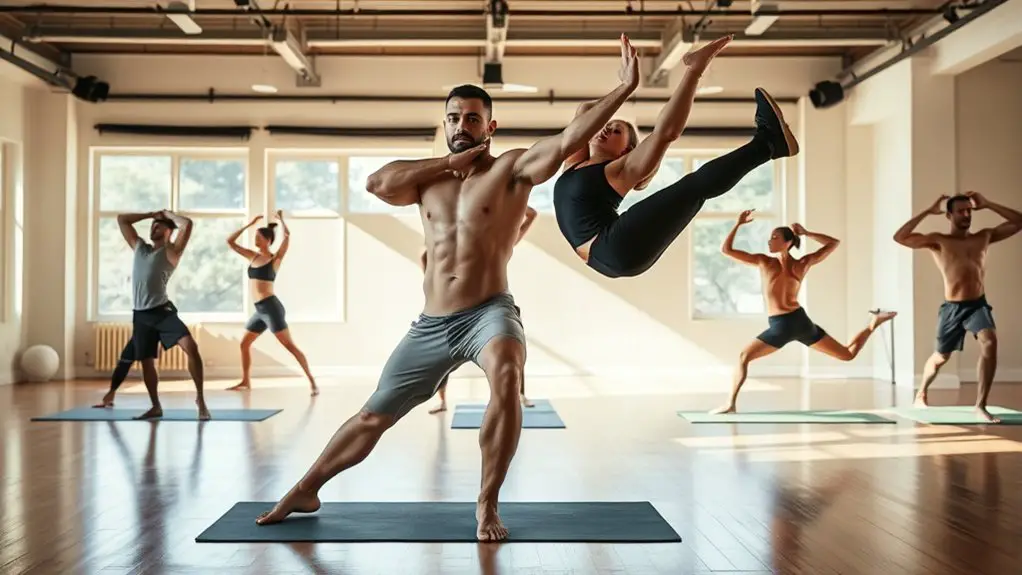
For strength athletes, incorporating yoga can markedly enhance performance. Focus on poses like Downward Dog for flexibility, Plank and Boat for core strength, and Pigeon for hip openness. These poses improve recovery, reduce soreness, and cultivate mental focus. Additionally, warming up with gentle stretches prepares your muscles and enhances flexibility. Don’t forget to integrate mindful breathing to boost endurance. Discover how these practices can transform your routine and support your training goals further.
The Benefits of Yoga for Strength Athletes
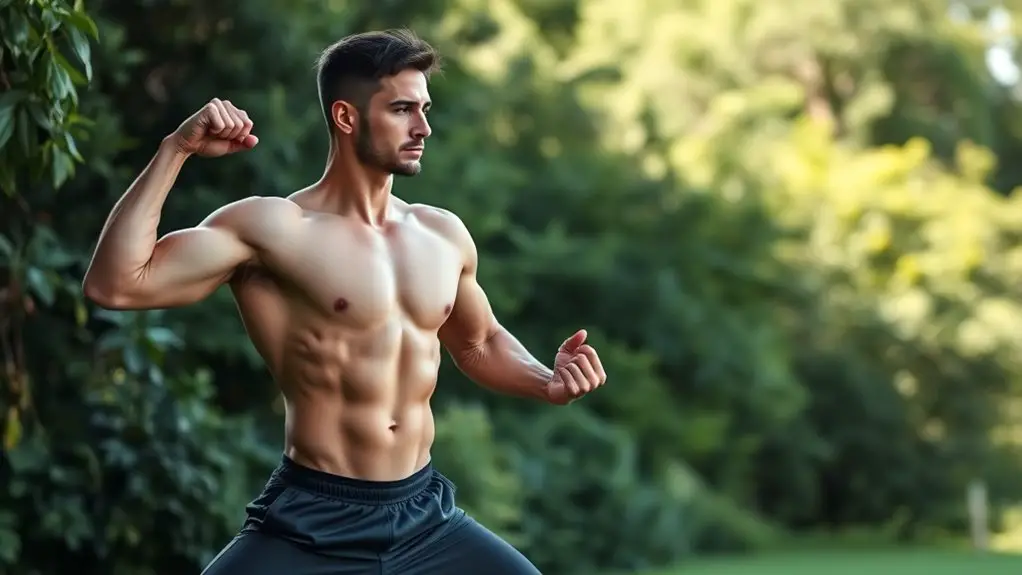
Yoga offers a wealth of benefits for strength athletes, especially when you’re looking to enhance your performance and recovery. Integrating yoga into your routine can greatly improve your yoga recovery, allowing your muscles to repair and rejuvenate after intense workouts. This practice promotes increased blood flow, which helps reduce soreness and speeds up healing.
Moreover, yoga cultivates mental focus, an essential element for any strength athlete. By incorporating breath control and mindfulness, you’ll sharpen your concentration, enabling you to stay present during training and competition. This heightened awareness not only aids in executing lifts with precision but also helps in overcoming mental barriers.
As you embrace yoga, you’ll find that it supports your physical goals while nurturing your mental resilience. Ultimately, the combination of improved recovery and enhanced mental focus will elevate your overall performance, making yoga an invaluable addition to your training arsenal.
Key Yoga Poses for Improved Flexibility
While strength athletes often prioritize power and endurance, improving flexibility is essential for overall performance and injury prevention. Incorporating key yoga poses can greatly enhance your flexibility and complement your training routine. Start with Downward Dog to stretch your hamstrings and calves, then move into Pigeon Pose for hip flexibility.
You might find that certain poses require yoga modifications to fit your current range of motion, so don’t hesitate to use props like blocks or straps. Additionally, consider using flexibility assessments to identify areas that need improvement.
Incorporating poses like Cobra and Forward Fold can also help open up your spine and shoulders, promoting better movement mechanics. Remember, flexibility isn’t just about stretching; it’s about creating a balanced body that can perform at its peak. Regular yoga practice can lead to noticeable gains, making it a valuable tool in your strength training arsenal.
Strengthening Your Core With Yoga
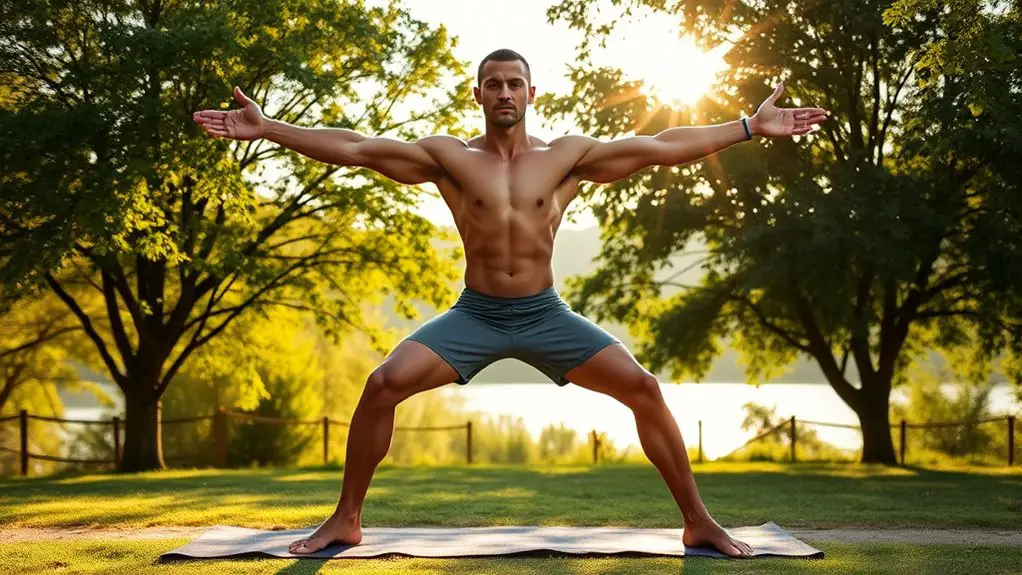
Strengthening your core is essential for overall stability and improved performance in strength training. By incorporating key yoga poses, you can enhance your core strength while also benefiting from effective breathing techniques. Let’s explore how these practices can elevate your training routine and support your athletic goals.
Importance of Core Stability
Core stability is essential for athletes looking to enhance their performance and prevent injuries. A strong core supports your entire body, allowing you to execute movements with power and precision. When you practice core engagement through yoga, you’re not just building strength; you’re also improving your balance and posture. Stability exercises, such as planks and bridge poses, help activate deep abdominal muscles, which can translate into better lifting techniques and reduced risk of strains. By incorporating yoga into your training regimen, you’ll develop the stability needed to perform at your best. Plus, a stable core contributes to overall body awareness, helping you maintain control during complex movements. So, prioritize core stability—your body will thank you!
Key Yoga Poses
Incorporating key yoga poses into your routine can greatly enhance your core strength, ultimately benefiting your performance as a strength athlete. Poses like Plank, Boat, and Side Plank are fantastic for building stability and endurance in your core. You can explore yoga variations of these poses to target different muscle groups or intensify the challenge. For example, try elevating your feet in Plank or extending your legs in Boat pose. Don’t hesitate to use pose modifications, like dropping to your knees in Plank, to guarantee proper form and prevent injury. By integrating these specific poses into your training, you’ll not only improve your core strength but also support your overall athletic performance.
Incorporating Breathing Techniques
While building strength through key yoga poses is important, pairing these movements with effective breathing techniques can elevate your practice even further. By focusing on breath control, you can enhance your core engagement during each pose. Mindful breathing helps you stay present, allowing you to connect deeply with your body and its movements.
As you inhale, envision your core expanding, and as you exhale, draw your navel in, creating stability and strength. This rhythmic pattern not only supports your physical practice but also calms your mind, fostering a more profound connection between breath and movement. Incorporating these techniques into your routine can lead to improved strength and endurance, making every session more effective. So, breathe mindfully and strengthen your core!
Enhancing Balance and Stability
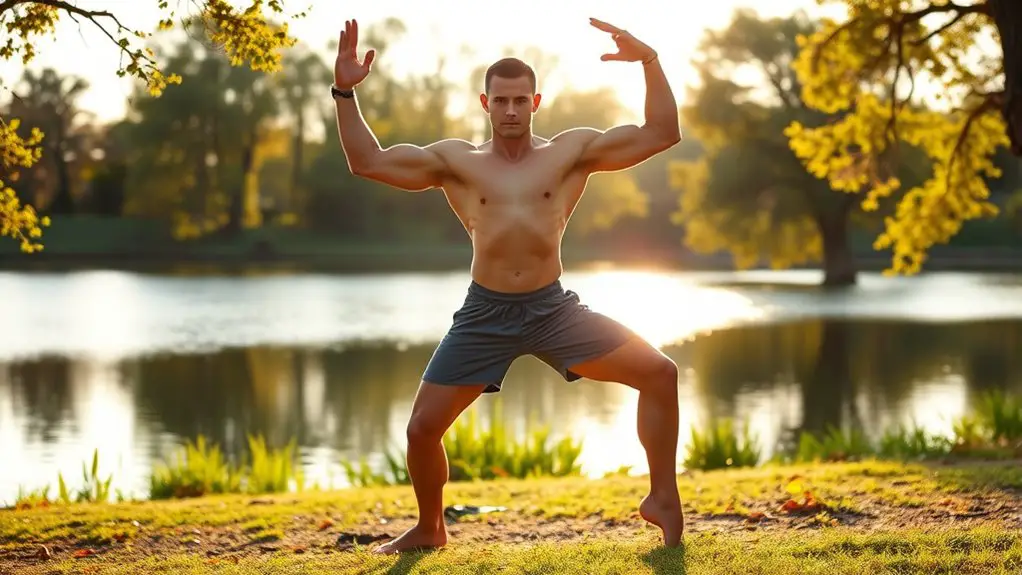
When it comes to enhancing balance and stability, core stability techniques and lower body strengtheners play a vital role. Incorporating yoga poses can help you develop a solid foundation, making your lifts more effective and safer. Let’s explore how these practices can elevate your performance on and off the mat.
Core Stability Techniques
To enhance your performance as a strength athlete, mastering core stability techniques is essential for achieving better balance and stability. Core engagement is the foundation of these techniques, allowing you to maintain control during heavy lifts. Incorporating stability exercises like the plank or boat pose into your routine can greatly improve your overall strength. For instance, while in a plank, focus on drawing your belly button toward your spine to activate your core effectively. This not only strengthens your abs but also stabilizes your entire body. Remember to practice these exercises regularly, as consistency is key to strengthening your core. By prioritizing core stability, you’ll notice improved performance in your lifts and reduced risk of injury.
Lower Body Strengtheners
Incorporating lower body strengtheners into your routine not only enhances your balance and stability but also supports your overall performance as a strength athlete. Focus on hip openers like Pigeon Pose and Bound Angle Pose, which improve flexibility and range of motion in your hips. These poses help prevent injuries and enhance your ability to lift heavier weights. Additionally, include leg stretches such as Forward Fold and Warrior II to target your hamstrings and quadriceps. These stretches will not only lengthen your muscles but also engage your core, providing a solid foundation for all your lifts. By integrating these practices, you’ll notice improved stability during lifts, helping you achieve greater strength and performance gains.
Incorporating Breathing Techniques
While many strength athletes focus primarily on physical training, integrating effective breathing techniques can greatly enhance performance and recovery. By incorporating mindful breathing practices into your routine, you can improve your focus, reduce stress, and increase your overall endurance.
Start with diaphragmatic breathing, which helps you maximize oxygen intake. Inhale deeply through your nose, allowing your belly to rise, then exhale slowly through your mouth. This technique not only calms your nervous system but also prepares you mentally for your workouts.
Another valuable practice is box breathing, where you inhale for four counts, hold for four, exhale for four, and hold again for four. This method promotes mindfulness and keeps your mind clear during intense training sessions.
Creating a Balanced Yoga Routine for Strength Training
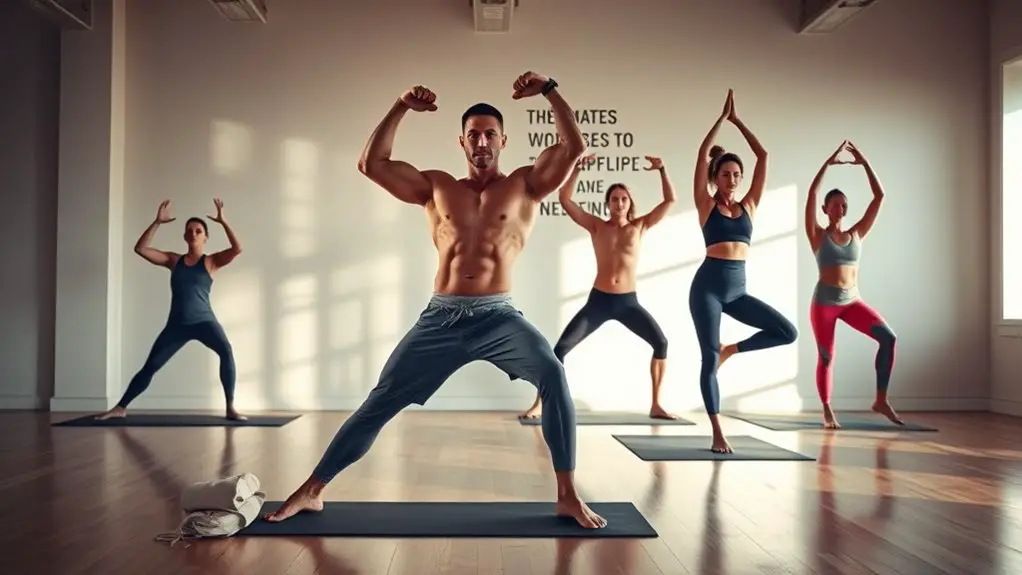
Creating a balanced yoga routine for strength training can elevate your performance and aid in recovery. By incorporating yoga sequence variations, you can enhance flexibility and stability, which are essential for strength training integration. Here are some tips to create your routine:
- Warm-Up: Start with gentle stretches to prep your muscles.
- Focus on Key Poses: Include poses like Downward Dog, Warrior II, and Pigeon to engage various muscle groups.
- Balance Strength and Flexibility: Pair strength-focused poses with deep stretches to avoid tightness.
- Cool Down: End with restorative poses like Child’s Pose or Savasana to promote relaxation and recovery.
- Listen to Your Body: Adjust poses based on your needs and energy levels to guarantee you’re getting the most benefit.
Frequently Asked Questions
How Often Should Strength Athletes Practice Yoga?
If you’re a strength athlete, finding the right yoga frequency is key to achieving training balance. Generally, practicing yoga 1-3 times a week can help improve flexibility, recovery, and mental focus without compromising your strength training. Listen to your body; if you’re feeling tight or fatigued, adding an extra session can be beneficial. Ultimately, incorporating yoga into your routine can enhance your performance and prevent injuries while supporting your overall goals.
Can Yoga Replace Strength Training Entirely?
Yoga can’t replace strength training entirely, but it offers significant benefits. While it enhances flexibility, balance, and mental focus, it doesn’t provide the same muscle-building stimulus as weightlifting. You’ll gain strength through resistance training, which is essential for muscle growth. However, incorporating yoga into your routine can complement your strength training, helping with recovery and injury prevention. So, while both practices are valuable, they serve distinct purposes in your fitness journey.
What Is the Best Time of Day for Yoga?
The best time of day for yoga really depends on your personal preference and schedule. Morning sessions can energize you for the day, helping to boost focus and flexibility. If you’re looking for evening relaxation, practicing yoga can help you unwind and relieve stress after a long day. Experiment with both times to see when you feel most connected to your practice and how it fits into your overall routine.
Are There Specific Yoga Styles Best for Strength Athletes?
When considering yoga styles for strength athletes, you might find power yoga particularly beneficial. It emphasizes strength-building poses and can enhance your overall performance. On the other hand, restorative yoga is great for recovery, allowing your muscles to relax and heal after intense workouts. Balancing both styles can optimize your strength training regimen, ensuring you build power while also promoting flexibility and recovery. So, mixing them could be a game-changer for your routine!
How Can Yoga Help With Injury Recovery for Strength Athletes?
Think of yoga as a soothing balm for your body, especially during injury recovery. It’s not just about relaxation; it’s essential for injury prevention and flexibility enhancement. Through gentle stretches and mindful movements, you can improve circulation, reduce tension, and promote healing. Incorporating yoga into your routine helps you regain strength and mobility more efficiently, allowing you to bounce back stronger than ever and ready to tackle your next challenge.



